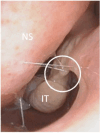Bilateral Inferior Head Turbinate Agenesis
- PMID: 39539890
- PMCID: PMC11558961
- DOI: 10.7759/cureus.71429
Bilateral Inferior Head Turbinate Agenesis
Abstract
Inferior nasal turbinates play a crucial role in conditioning inhaled air. While hypertrophy of these turbinates is a common cause of nasal obstruction in adults, congenital malformations are extremely rare. Only a few cases of unilateral agenesis have been reported. This report presents the first documented case of bilateral inferior head turbinate agenesis (BITHA). A 22-year-old woman with a history of chronic nasal obstruction, sneezing, and nasal itching was diagnosed with BITHA. Her medical history included trisomy 14 mosaicism and other comorbidities. Clinical examination revealed mild facial dysmorphic features and agenesis of both inferior turbinate heads. Nasal endoscopy showed compensatory hypertrophy of the middle and posterior portions of the inferior turbinates. Following a one-month treatment with nasal corticosteroids and antihistamines, her nasal symptoms improved. Trisomy 14 mosaicism is a rare genetic condition often associated with unspecific dysmorphic features. To our knowledge, BITHA has not been previously reported in such patients. This case suggests that BITHA could be a clinical feature for trisomy 14 mosaicism. Additionally, the absence of empty nose syndrome (ENS) in this patient, despite BITHA, provides insights into the potential iatrogenic origin of ENS. BITHA is an exceptional congenital anomaly and may serve as a specific sign of trisomy 14 mosaicism. The lack of ENS in this case supports the hypothesis that ENS may arise from acquired rather than congenital anatomical changes.
Keywords: congenital nasal malformation; empty nose syndrome; nasal obstruction; trisomy 14; turbinate.
Copyright © 2024, Drabkin et al.
Conflict of interest statement
Human subjects: Consent was obtained or waived by all participants in this study. Conflicts of interest: In compliance with the ICMJE uniform disclosure form, all authors declare the following: Payment/services info: All authors have declared that no financial support was received from any organization for the submitted work. Financial relationships: All authors have declared that they have no financial relationships at present or within the previous three years with any organizations that might have an interest in the submitted work. Other relationships: All authors have declared that there are no other relationships or activities that could appear to have influenced the submitted work.
Figures



References
-
- Anatomy and physiology of the upper airway. Sahin-Yilmaz A, Naclerio RM. Proc Am Thorac Soc. 2011;8:31–39. - PubMed
-
- Definition, prevalence and development of nasal obstruction. Jessen M, Malm L. Allergy. 1997;52:3–6. - PubMed
-
- Unilateral agenesis of middle nasal turbinate. Aydil U, Ozçelik T. J Laryngol Otol. 2010;124:447–449. - PubMed
Publication types
LinkOut - more resources
Full Text Sources
